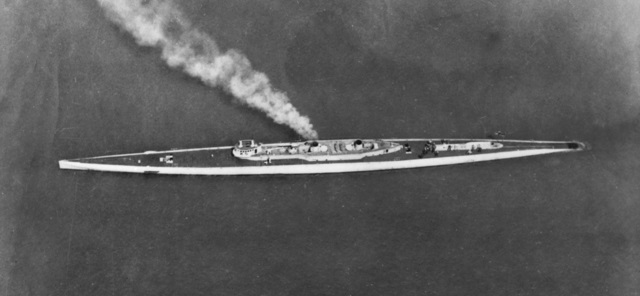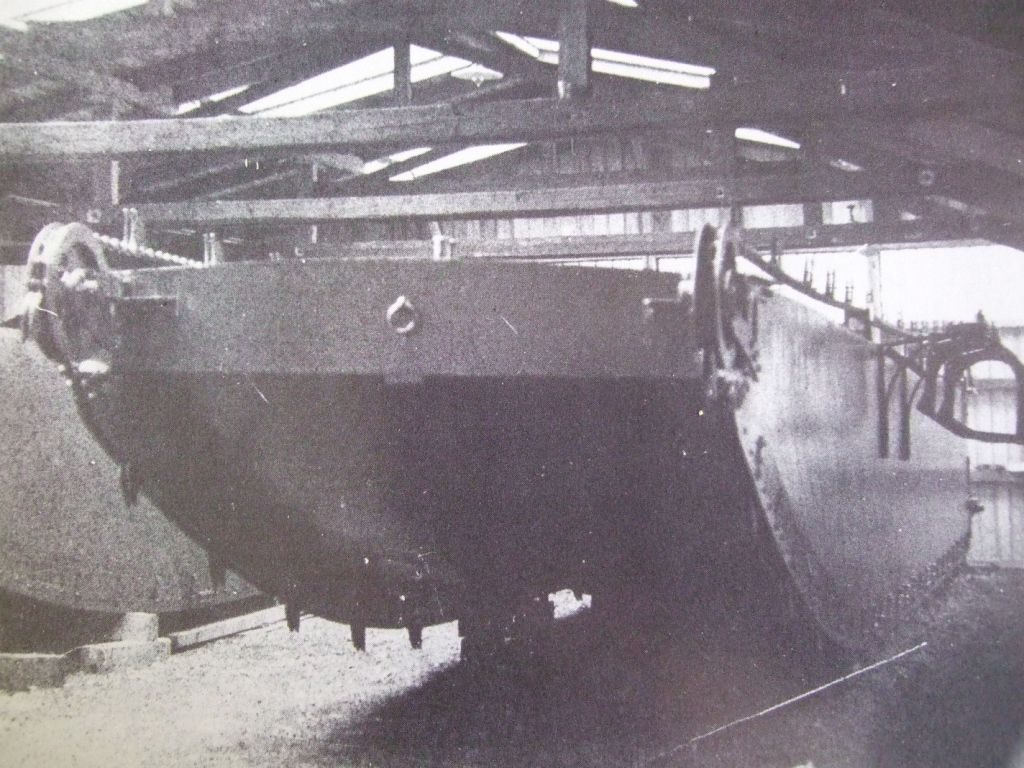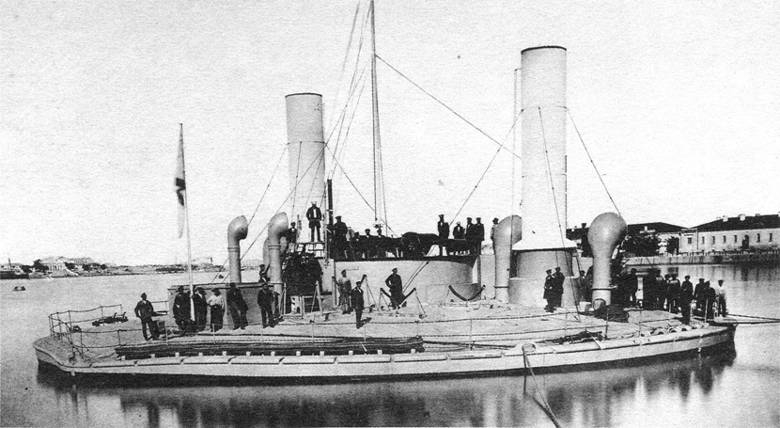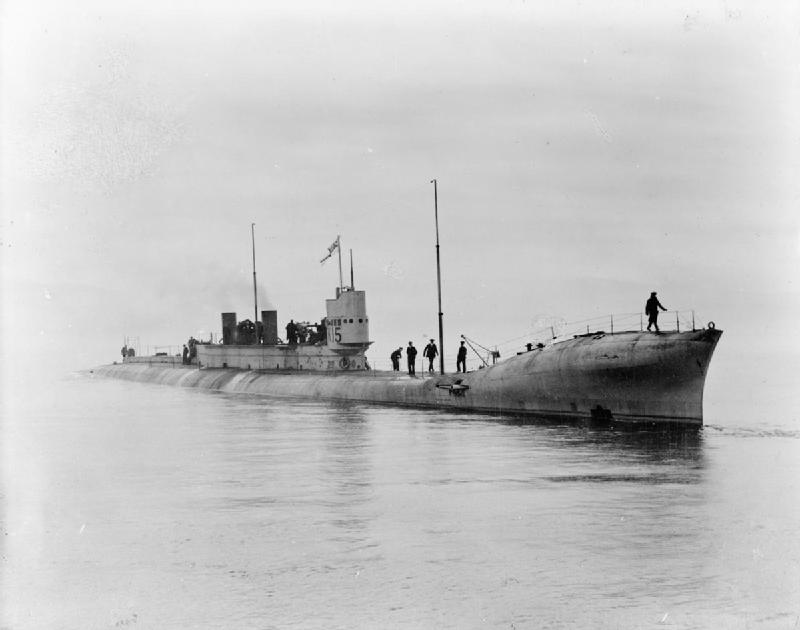We are honoured to present a piece by our contributor Andy South! Andy touches on a few of the naval oddities at sea, specifically the infamous K class submarines of the Royal Navy. Andy has been hard at work putting together a book on these submarines. This article only gives a small taste of what Andy’s book has to offer! – Navy General
Oddities at Sea
by Andy South
There have been a number of ‘Heath-Robinson’ style Warship designs within the past two hundred years. Concepts that were tried, tested and failed.
The Italians designed and commissioned the Grillo-class tracked torpedo motorboat. The treads of the Grillo-class “jumping boats” were fitted with hooked chains to help the boat to climb harbour obstacles, and drag the torpedo boat over them. The concept actually worked in practice but on the 13th May 1918 the lead boat of the class, the Grillo herself undertook a ‘stealth’ mission, but the noise of the chains clanking gave her presence away. She was spotted and destroyed while climbing over the harbor’s booms. The Austria-Hungarian’s copied the concept but it was to late in the war to see action.
In the 1870’s Imperial Russia built the (Новгород) Novgorod which was a circular monitor. She has the distinction of being possibly the most unusual warships ever to be constructed and may have been one of the worst warships ever built.
The French built the square porthole battleship Carnot in the late 1890s. The iron hulked colossus rose from the sea, looking not unlike a twin funneled Victorian land fortress. Her hull had a bulbous waterline which extended all around her lower hull. The countless square portholes were only interrupted by the large caliber single-gun turrets spread throughout the hull. In time it was conceived so many portholes would endanger the ship should she go into battle and they were blanked over. Finally on the outbreak of war, when the French navy’s moment came, she was withdrawn from service.
In the 1880’s the British built the battleship Sans Pareil. The ship had an armored superstructure with port holes extending around the entire stern portion of the ship. The lower fore-end held two 111 ton 16.25 inch (413 mm), breech-loading guns mounted into a turret. These were to be the largest guns ever to be fitted on any Royal Navy warship in history. But despite their awe inspiring calibre the 111 ton monsters were slow to reload, plus they had a tendency to droop and crack under their own immense weight, giving them a barrel lifespan of a paltry 75 firings.
But all these designs lacked one factor. Their crews weren’t nervous of serving on their ships. They might be uncomfortable or impractical but they were not killers of their own crews. That distinction must rest with a British attempt at their first Fleet Submarines, the steam powered ‘K’ class. Their machinery would result in a submersible the size of a light cruiser and a ‘crash’ dive almost best counted on a calendar! By the time the Admirals accepted the design was a dead end or just unwise, over 200 crew had perished. Having decided to quietly dispose of all but one, after less than a decades service, the Admiralty ordered the class files sealed and locked away for 75 years. By the time some files were released into the National Archives the ‘great’ minds that had conceived of fitting a steam engine in an underwater craft had passed away and were beyond embarrassment. But even today, the available records are incomplete and some still remain beyond the publics reach.
The ‘K’ boats weren’t unique, the French were to put steam engines in a submarines hull almost a decade before their allies. As the Great War wound its way towards November 1918, the German navy dabbled with the concept, only prevented in seeing the plan develop to full bloom by the Armistice. But despite good intentions, both the French and British creations were to fail in their expectations. The French seaman were the more fortunate, not having to pay the ultimate price for the ‘Heath-Robinson’ concept, by laying down their lives.
Imperial War Museum Archives: SP 2506
The British ‘K’ class faced the enemy once, a meeting that ended in a strategic withdraw by both parties. The steam monsters were also to be present at just one ‘battle’. Whilst the Royal Navy attended, the enemy were absent. But no enemy was not to stop the ‘jinx’ that rode with most ‘K’ boats, be it at sea or alongside whilst in harbour. Despite the lack of hostile forces, 2 ‘K’ were sunk and an additional 4 damaged, with a heavy loss of life. Another ‘K’ boat crash dived too the bottom of a Scottish loch with her crew on board. Having been raised and those still alive rescued, she plummeted to the sea bed once more with a crew of the dead. Having been salvaged a second time she was refitted and renumbered K13 to K22. But it was to fool no one, she was a killer.
Another ‘K’ boat took the future King George VI and father to Queen Elizabeth II to the bottom of the Solent in an uncontrolled crash dive. Then there was the ‘K’ boat’s captain who claimed a mouse ate his chart causing him to plough his boat ashore. Even the outbreak of Peace brought no relief, with the loss of the K5 off the Isles of Scilly along with her entire crew. The ‘K’ boat too many servicemen was jinxed, cursed and the worst billet within the service.
Since April 2019 I have explored the files held deep within the National Archives in Kew, London. Over 2000 pages were recorded and examined during my time in the Archives and I even claim to have rewritten ‘popular’ history, debunking the chart consuming rodent and plausibly explaining why the K5 never surfaced that day in the English Channel. The finished work, ‘THE SUICIDE CLUB – A HISTORY OF THE ROYAL NAVY’S STEAM POWERED ‘K’ CLASS SUBMARINES’ by ANDY SOUTH covers two comprehensive volumes. The first book details the boats mechanics, the thinking behind their inception and their flawed time in commission. The pages are heavily illustrated and includes both photos never published before and source material provided by the Queens archives at Windsor.
Volume 2 holds two full and unabridged Wartime memoirs written by serving crew members. Among it’s pages are technical tables drawn from the Kew files, Captain lists and details on the flotillas the boats served in. Volume 2 is also free for a limited time!
The complete work is unique in its depth and offers a level of research into the class that I believe has never been seen before. It will be published on Amazon with both volumes in Kindle format and volume one in paperback on the 28th March 2020.
For other articles by Andy South
- HMS Agincourt, The Gin Palace
- HMAS Sydney: The Prewar Years
- His Excellent Facebook Group: The First World War at Sea







Recent Comments